RANTHAMBORE INFORMATION

Ranthambore is a heritage site because of the picturesque ruins that dot
the park. There are lake palaces, 'chhatris', old fortifications and a majestic
1,000-year-old fort overlooking the park. The lovely Jogi Mahal is located
at the foot of the fort and gives magnificent view of the Padam Talao, painted
white with water lilies.
It has a chequered history and was the stronghold of the Yadavas in the
8th century. It came under Chauhans, and was ruled by them 10th century
onwards. The Mughal emperors Akbar and Aurangzeb also occupied the magnificent
fort.
The park is famous for tigers and due to conservation efforts, the tiger
population has stabilized if not increased here. The tigers can be spotted
quite often even during the day, at their normal pursuits-- hunting and
taking care of their young ones.
Ranthambore is one of the best places to see these majestic predators. Old
crumbling walls, ruined pavilions, wells, and other ancient structures stand
witness to the region's glorious past. The entire forest is peppered with
the battlements and spillovers of the Ranthamboree fort - tigers are said
to frequent these ruins, too.
Ranthambore National Park: 
Ranthambore
National Park is an outstanding example of Project Tiger's efforts at conservation
in the country. The forests around the Ranthamboree Fort were once, the
private hunting grounds of the Maharajas of Jaipur. The desire to preserve
the game in these forests for sport was responsible for their conservation,
and subsequent rescue by Project Tiger. In 1972, it was estimated that there
were around 1927 tigers in India, of which Rajasthan had 74, and the number
of big cats in Ranthamboree Sanctuary was 14. 1972 was also the year that
Project Tiger was launched, and this sanctuary was taken into its wings,
alongwith seven other sanctuaries and national parks.
As a result of stringent efforts in conservation, tigers, the prime assets
of the park, have become more and more active during the day. More than
in any other park or sanctuary in India, tigers are easily spotted here
in daylight. They can be seen lolling around lazily in the sun, or feverishly
hunting down Sambhar around the lakes. Therefore, Ranthamboree is probably
the ideal park for wildlife photography, and it does attract professional
wildlife photographers, from all over the globe.
The Fort: Steep crags embrace a network of lakes and rivers, and
atop one of these hills, is the impressive Ranthamboree Fort. Built in the
10th century, the fort is considered to be one of the oldest forts in the
state. Strategically built on the border of Rajasthan and Malwa, the fort
houses some splendid monuments, within its precincts. The terrain fluctuates
between impregnable forests and open bush land. The forest is the typically
dry deciduous type, with Dhok, being the most prominent tree.
The Jogi Mahal: T
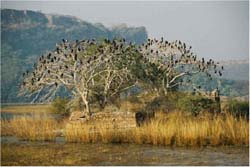
he
entry point to the park, goes straight to the foot of the fort and the forest
rest house, Jogi Mahal. The latter boasts of the second-largest Banyan tree
in India.
The Badal Mahal: The “palace of the clouds”, situated in the fort
has a very interesting location and seems as if hanging out in space. The
famous 84-column 'chhatri' of King Hammir stands out magnificently where
he used to hold an audience. The Padam Talab, the Raj Bagh Talab and the
Milak Talab are some of the lakes in the area worth seeing.
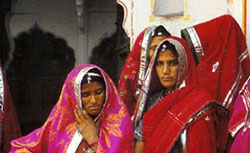
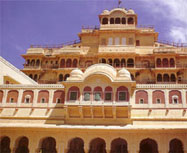
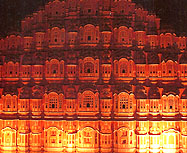
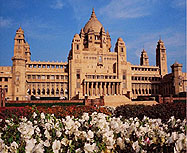
 Ranthambore
National Park is an outstanding example of Project Tiger's efforts at conservation
in the country. The forests around the Ranthamboree Fort were once, the
private hunting grounds of the Maharajas of Jaipur. The desire to preserve
the game in these forests for sport was responsible for their conservation,
and subsequent rescue by Project Tiger. In 1972, it was estimated that there
were around 1927 tigers in India, of which Rajasthan had 74, and the number
of big cats in Ranthamboree Sanctuary was 14. 1972 was also the year that
Project Tiger was launched, and this sanctuary was taken into its wings,
alongwith seven other sanctuaries and national parks.
Ranthambore
National Park is an outstanding example of Project Tiger's efforts at conservation
in the country. The forests around the Ranthamboree Fort were once, the
private hunting grounds of the Maharajas of Jaipur. The desire to preserve
the game in these forests for sport was responsible for their conservation,
and subsequent rescue by Project Tiger. In 1972, it was estimated that there
were around 1927 tigers in India, of which Rajasthan had 74, and the number
of big cats in Ranthamboree Sanctuary was 14. 1972 was also the year that
Project Tiger was launched, and this sanctuary was taken into its wings,
alongwith seven other sanctuaries and national parks. he
entry point to the park, goes straight to the foot of the fort and the forest
rest house, Jogi Mahal. The latter boasts of the second-largest Banyan tree
in India.
he
entry point to the park, goes straight to the foot of the fort and the forest
rest house, Jogi Mahal. The latter boasts of the second-largest Banyan tree
in India.